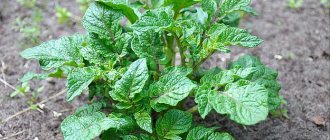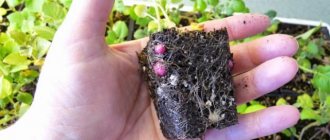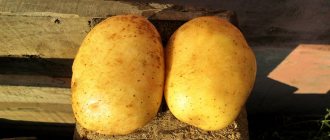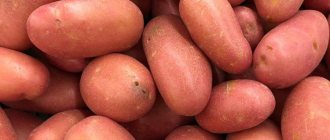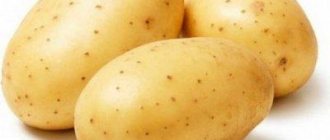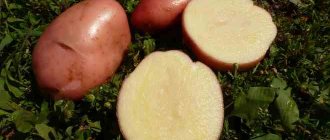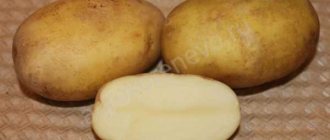Which potato variety to choose
When choosing potatoes, you may find that Dutch ones are considered the best. In general, foreign varieties grown on the basis of hormones and suspicious fertilizers, prohibited as carriers of GMOs, have many advantages. But domestic varieties are still considered competitive. Which varieties are the most popular?
- Zhukovsky early - its ripening time is 70-80 days. This variety is loved for its plasticity. It also has good yields. Even low temperatures won't bother him. It also has some of the best taste;
- Spring white is also an early ripening plant. This variety is a table variety and has high marketability. Potatoes have beautiful white tubers. The variety is considered tasty;
- Timo Hankkiyan has a good marketable mass of tuber. This variety was imported from Finland. All types of soil are suitable for cultivation. The tubers are round in shape, white, with good taste. Its shoots are friendly and strong. The variety is suitable when it is to be grown in drought;
- Udacha is another early ripening variety. He is very popular. You can get a large number of fruits. The first commercial harvest is obtained in June;
- Povin is an early variety of Ukrainian selection. A very popular variety. The peel is red, the tubers are round, medium in size;
- Borodyansky pink is a mid-early variety of Ukrainian selection. The peel is pink, the tubers are round, medium size;
- Dnepryanka is an early variety of Ukrainian selection. The peel is yellow, the tubers are round and large;
- Lugovskoy is a mid-season variety of Ukrainian selection. The peel is pink, the tubers are oval, large;
- Tiras is an early variety of Ukrainian selection. The peel is pink, the eye stands out bright red, the tubers are oval, large;
- Slavyanka is a mid-season variety of Ukrainian selection. The peel is red, the tubers are round and large;
- Fantasia is a mid-season variety of Ukrainian selection. The peel is pink, the tubers are oval, large;
- Shchedryk is a mid-early variety of Ukrainian selection. The peel is yellow, the eye stands out bright red, the tubers are oval and large.
Potato varieties: medium and late
Here is a description of potato varieties of medium and late ripening.
"Sante." The tubers are large, yellow, oval, weighing about 100 g. The eyes are small, numerous, the flesh is light yellow.
Ripening period is 80-90 days. Excellent taste. Good keeping quality. Productivity is high. High resistance to various diseases: late blight, potato cancer and nematodes, practically not susceptible, moderately resistant to scab, less resistant to rhizoctonia.
"Zekura." The tubers are oblong in shape with a yellow smooth skin, weighing 120-150 g. The eyes are small, the flesh is yellow.
Article on the topic: Potato variety “Nida” - description and photo
Ripening period is 80-90 days. Excellent taste. Good shelf life. Productivity is high.
Resistant to cancer and potato nematode. Weakly susceptible to leaf curl virus, late blight of leaves and tubers.
"Albatross". The tubers are oval-shaped, weighing 70-100 g, the peel is rough, yellow. The eyes are small, the flesh is yellow. Ripening period is 90-110 days.
Good taste. Good shelf life. Productivity is high. Resistant to the causative agent of potato cancer, golden potato cyst nematode. Moderately susceptible to late blight.
"Kolobok" The tubers are round in shape, the skin is slightly rough, yellow, weighing 90-120g. The eyes are medium to deep, the flesh is yellow.
Ripening time is about 90-110 days. Good taste. Excellent shelf life. Productivity is high. Resistant to the pathogen of potato cancer, susceptible to golden potato cyst nematode.
Brief tips on agricultural technology
When selecting a potato variety for planting, it is necessary to study the various growing conditions and soil characteristics in Ukraine. Based on this, it will be easier to choose the variety you are interested in. Pay attention to studying agricultural cultivation techniques, become familiar with moisture conservation techniques such as loosening and mulching potatoes, look at planting patterns and drip irrigation.
In addition, it is advisable to take note of compliance with crop rotation requirements, otherwise the soil will be depleted and diseases and pests that are dangerous for nightshades will accumulate in it. Green manure will help restore the soil.
Characteristics
Let’s touch a little on the characteristics of potatoes based on their ripening time. Potatoes of early varieties, although they produce less yield, due to their early ripening, provide early vitamins and nutrition. Often, gardeners choose early potato varieties because they tolerate dry times well and have time to gain weight. Proper collection and timely removal of tops will protect potato tubers from late blight. Many of them are well kept.
Mid-season varieties are more often susceptible to fungal diseases, and therefore require more care (regular spraying, pruning of affected tops). But you can select such high-yielding varieties that you will provide yourself and all your relatives with wonderful potatoes until the beginning of summer.
Late varieties are also demanding of care; usually these potatoes are harvested before the end of September. They are not recommended to be planted in the south, since the plants suffer greatly from drought and when the heat sets in, they try to withstand a dormant period without growing tubers. Depending on the variety, the yield is high; tubers are subject to long-term storage.
Flesh colors
Naturally, if you are deciding for the first time which variety of potatoes to choose for planting, you need to look at a lot of photos and read the descriptions. Perhaps you will choose a variety with colored pulp that is new to our latitudes. In the West and the American continent, they love varieties with pulp of cranberry, beet, blue, purple, and so on.
Our consciousness is still familiar with the creamy, yellow and occasionally pinkish colors of the pulp. Perhaps this is temporary. After all, the colored pulp contains many useful substances.
We looked at several varieties. There are many more of them. Famous Dutch Condor, Picasso, Courage, Romano, Carrera and Sante, which taste good and last a long time. Dutch early Ariel, Riviera, Prior, Red Scarlett, Estima manage to produce a magnificent harvest before being affected by late blight. Remember that an accurate conclusion can only be drawn from experience, multiplied by the desire to get results. You can only understand which varieties of potatoes in the photo are better through practice.
The history of the origin of the Ladoshka potato variety
“Ladoshka” is the popular name of the variety.
The variety is not officially registered in the Russian register.
Nevertheless, it is grown on personal plots and on farms.
The table shows data on the growing season of different potato varieties:
| Name | Variety | Days |
| Nikulinsky | Late ripening | 115-120 |
| Cardinal | Late ripening | 110-120 |
| Rocco | Late ripening | 100-115 |
| Kiwi | Late ripening | 120-130 |
| Ivan da Marya | Late ripening | 115-130 |
| Slav | Late ripening | From 125 to 140 |
| Borovichok | Early ripening | 70-90 |
| Elmundo | Early ripening | 70-80 |
| Felox | Early ripening | From 65 to 70 |
| Bellarosa | Early ripening | From 50 to 70 |
| Natasha | Early ripening | From 70 to 80 |
| Karatop | Extra early | From 60 to 65 |
| Riviera | Extra early | From 40 to 80 |
| Zhukovsky early | Extra early | 60 to 70 |
| Farmer | Extra early | From 50 to 60 |
| Minerva | Extra early | 45-50 |
| Crane | Mid-late | From 100 to 120 |
| Sorcerer | Mid-late | 80-90 |
| Mozart | Mid-late | From 100 to 180 |
| Ramona | Mid-late | From 80 to 100 |
| Limonka or Picasso | Mid-late | 120-130 |
| Yanka | Mid-early | 90-100 |
| Giant | Mid-early | From 80 to 100 |
| Tuscany | Mid-early | 70-90 |
| Purple Haze | Mid-early | 90-100 |
| Openwork | Mid-early | 75-85 |
Mid-season varieties
"Sante"
A variety respected by many gardeners because it gives good yield results and is intended for table use. Suitable for making chips and French fries.
The bushes are small, one might say medium, and have a compact structure. The foliage is densely developed. The flowers are moderate, white in color.
The root crop is large, oval in shape. Yellow, smooth peel, strewn with small eyes. The taste is at the highest level, the starch content is only 11%.
The fertility of this variety allows you to collect as many as 500 centners of potatoes from one hectare plot.
Resistance to nematodes, late blight, fusarium, and cancer.
"Picasso"
A prolific intensive variety that is not indifferent to fertilizer, but does not require frequent watering. Bred by Dutch breeders.
A distinctive feature of such potatoes is the color of the tubers - they are white with reddish spots. As for the pulp, it is cream-colored. Quite tasty and homogeneous.
Good yield level - up to 570 c/ha at the end of the growing season. The weight of each potato is from 100 to 120 grams. There are an average of 17 tubers per bush.
High starch content - 18%.
It is resistant to viruses, scab, fusarosis and cancer diseases.
Description of the variety
Roots:
- Large tubers;
- Oval or oval-round, slightly flattened;
- The peel is white or cream-colored;
- The eyes are superficially recessed, light pink in color;
- With white or creamy pulp;
- Starch content from 12 to 15%;
- The average weight varies from 180 to 250 grams.
Selecting potato varieties:
Bushes:
- The plant is erect or semi-erect, intermediate type;
- The bushes are medium-sized, moderately spreading, with an average formation of green mass;
- Dense leaves of a dark green color, medium-sized, slightly wavy edges and clearly defined veins;
- The flowers are white or pale pink, have a brightly colored core, and form compact corollas;
- Early falling flowers;
- Rare formation of berries or its complete absence;
- The plant has a well-developed root system.
Characteristics of the variety
Potato bushes grow medium or tall, semi-erect, of intermediate growth type. The leaves are medium in size, closed or intermediate in type, predominantly dark green in color. The edge of the leaf plate is characterized by slight waviness. The flower corollas are medium to large in size and colored reddish-purple.
Root vegetables are oval in shape, with very small eyes that do not spoil the presentation of the potato. The tubers are covered with a smooth or slightly rough red skin. The pulp is light yellow, closer to cream, in color. The average weight of one commercial tuber can vary from 80 to 156 g. The average starchiness of the pulp does not exceed 14.8%.
The taste of this potato variety is very good. The marketability of tubers is 83-96%. The keeping quality of tubers is 96%. Average marketable yields with proper care reach 332 c/ha, and in conditions of high agricultural technology they can be at the level of 366 c/ha. The average number of tubers per bush is 14-18 pieces.
The variety is characterized by resistance to the pathogen of potato cancer, and also has nematode resistance. Increased drought and heat resistance of the variety is observed
Peculiarities
Characteristic features include:
- Mid-early ripening. The growing season ranges from 65 to 80 days;
- Productivity up to 450 centners per hectare;
- Frost intolerance;
- Cultivation on heavy clay soils and constant stagnation of water contributes to a significant reduction in yield;
- The seed material does not degenerate; it is allowed to plant tubers whole or in parts with sprouts.
Correct fit
Basic rules for planting the Ladoshka variety:
- Medium-sized specimens without damage are selected as planting material. Pre-planting treatment of seed material with growth stimulants is carried out; it can be treated. Dried tubers are left to germinate in the open air or in damp sawdust;
- Give preference to light, fertile soils with black soil or sand;
- The timing of planting is determined by the climatic conditions of the growing region (late April - mid-May);
- A mixture of humus and wood ash is added to the planting holes;
- The distance between the bushes is from 30 to 35 cm. Leave the row spacing wide to facilitate further care of the plantings.
How to care for plantings:
- Carry out two or three hillings, forming high ridges;
- Mulching is effective in controlling weeds;
- Watering should be carried out as soon as the top layer of soil begins to dry out. During the season, two or three waterings are carried out so that the soil is soaked 40-50 cm deep;
- Fertilizing is not necessary, but prefer organic fertilizers: humus, diluted mullein, compost.
Diseases and pests
Potatoes of the “Ladoshka” variety do not affect:
- Potato cancer;
- Golden cyst nematode;
- A variety of viruses and rots: fusarium, alternaria, verticillium, scab.
Due to early ripening, tubers and leaves are not susceptible to late blight.
Necessary preventive measures:
- Maintaining crop rotation. During the rest period, the plots are sown with phacelia or oilseed radish. It is good to plant potatoes after legumes, cabbage, carrots or meadow grasses;
- Juicy young potato tops serve as bait for the Colorado potato beetle, spider mites, cicadas, and aphids. In severe cases of damage, industrial insecticides are used. Non-toxic biological products will serve as their replacement;
- Plantings can be protected by timely weeding and mulching;
- To prevent wireworms, it is effective to treat the tubers and water the soil before planting using disinfectant solutions.
Reviews about the variety
Ladoshka potatoes have a pleasant rich taste, without excessive dryness or wateriness. Despite the length of cooking, the tubers do not lose their shape. The variety is versatile: it can be boiled, fried, stewed, baked and stuffed. Tubers are suitable for making delicious puree. The pulp does not darken when cut and cooked.
We invite you to familiarize yourself with potato varieties that have different ripening periods:
Potatoes of the “Ladoshka” variety are popular due to their ease of care and high yields. It has excellent keeping quality, the seed material is not subject to degeneration, the variety is grown both for sale and for personal use.
In northern regions with short, hot summers, special varieties are needed to obtain a good potato harvest. Lapot potatoes are considered the best for these purposes. It is also called Sibirka, or Siberian Lapot. It is distinguished by its high yield and fast ripening period, as well as its unpretentiousness.
Advantages and disadvantages of the variety
variety is quickly spreading among gardeners due to its rapid ripening and high yield. The tubers are large and oval in shape, making them easy to clean. When cut, boiled potatoes of this variety do not fall apart, so they are ideal for salads.
Advantages:
- ability to grow in almost any conditions;
- early maturation;
- high yield - up to 650 c/ha.
- if the conditions are met, the crop is stored for a long time and does not lose its appearance or taste;
- correct shape of tubers;
- presence of immunity to a number of diseases.
Despite all the advantages, the Palace also has disadvantages :
- high tendency to become infected with late blight;
- poor cooking ability.
Growing regions
Preferred regions are not indicated for Palace potatoes, since the plant easily adapts to any climatic conditions . For the variety to ripen, 2-2.5 warm months are enough. Therefore, Palace is suitable for cultivation in both southern and northern regions.
History and description of the Lapot variety
It is unknown when and where the Lapot potato was bred. This is an early Russian variety that gained popularity at the end of the twentieth century. In pursuit of foreign varieties, unfortunately, it is rare to find gardeners who still grow it. However, there are those who remain faithful to this large-fruited early variety.
Potato tubers Light pink or gray-pink color
There is an opinion that the Lapot variety is the result of many years of “folk selection” based on the Ermak potato variety. You won’t wear Laptya varieties in the State Register.
The variety got its fancy name because of the shape of the tuber, which resembles a bast shoe both in size and appearance. This is one of the highest yielding varieties in the world. One medium potato produces up to 10 large tubers per hole, with an average weight of 200 grams. The yield is 500 centners per hectare. Harvest dates are mid-August or early September - potatoes are early-ripening varieties.
The ground part of the variety is medium-sized erect bushes, which at the time of flowering are covered with white flowers - a sign of active tuberization.
Young above-ground parts of potatoes are medium-sized erect bushes
The fruits are covered with light pink or gray-pink skin. The pulp is light cream in color with an average starch content (10–12%), pleasant to the taste, and softens when cooked.
The appearance of flowers is a sign of the beginning of tuberization
Table: advantages and disadvantages of the variety
| Advantages | Flaws |
| Large tubers of excellent taste | Low resistance to late blight |
| Low soil quality requirements | Often affected by wireworms |
| Tolerates light night frosts and drought | |
| Resistant to many diseases |
Description and characteristics
The Isle of Jura potato or simply Jura is a mid-early table variety intended for cultivation in the Central and Northern regions of Russia, as well as throughout Ukraine and Moldova.
The above potato variety was created more than 11 years ago by breeders from two countries: Russia and Great Britain. It got its name in honor of a small island near Scotland - Jura. In 2007, the variety was included in the State Register of Vegetable Crops, and since then has not lost popularity among farmers and summer residents.
Appearance of the variety
Jura forms quite powerful, spreading and erect bushes, with an average height of 40-60 cm. The green mass of the plant is presented in the form of numerous, large, elongated, slightly wavy leaves of a rich dark emerald color.
During flowering, medium-sized white flowers with virtually no aroma are formed at the very tops of the bushes. Several flowers are collected in large, whitish corollas. During the same period, the plant begins to form tubers. After this, emerald-colored berries form on the tops.
At the end of the summer season, tubers of the same size ripen under each bush, in the amount of 8-11 pieces - weighing from 120 to 180 g each, but there are specimens weighing more than 200 g. Potatoes - rounded-elongated, with a flat smooth surface, with a small number of small eyes. The peel is dense, uniformly yellow in color.
The pulp is creamy-yellow in color, uniform in structure, without spots. The taste of potatoes is pleasant, rich, oily, with a traditional potato flavor. After peeling, the potatoes do not darken and do not become soft when cooked. The pulp contains no more than 12-16% starch, making the tubers ideal for making purees, first courses, and casseroles.
In addition to high taste, Isle of Jura tubers are characterized by excellent commercial properties, estimated at 90%. It has excellent shelf life - more than 95% and, under optimal storage conditions, can be stored for several months. But, since the variety is an early ripening variety, it is recommended to use it immediately, without leaving it for long-term storage.
Did you know? The historical homeland of the potato is South America, where wild varieties of the crop grow even today. It was from these territories that the spread of the vegetable began throughout the world.
Ripening period
Jura belongs to the category of crops with early growing seasons, the harvest of which is ready for harvesting 70-80 days after planting the seeds. Conditional yield occurs in two months. During this period, it is allowed to dig up the tubers little by little in order to prepare soups from them or use the vegetable as “new potatoes”. The tubers have thin skin that is prone to peeling and a pleasant, characteristic vegetable taste.
Productivity
The described variety has good yield indicators. Under favorable climatic conditions and following the rules of plant care, 250-350 centners of tubers can be obtained from one hectare of land. The maximum yield was 415 centners per hectare.
Important! The main signal for harvesting potatoes is considered to be dried tops that fall to the ground
Disease resistance
Jura is characterized by excellent immunity to the most common diseases affecting nightshades - cancer, cyst nematode. Has average resistance to late blight. Most often it becomes a victim of the Colorado potato beetle, and therefore requires mandatory protection from the parasite.
Planting and care
When the soil warms up to 6–8 degrees Celsius, you can begin planting.
Selecting a location, preparing soil and planting material
The main requirement for the place is good lighting. The soil does not require special preparation, but the variety prefers light soil diluted with sand.
Site preparation has a positive effect on yields. In the fall, the land is planted with green manure herbs, for example, mustard (which the wireworm cannot tolerate) or oilseed radish.
Preparing the material for planting begins with warming up the tubers, which are taken out of storage and placed in boxes with good ventilation in a room where the temperature is more than 15 degrees. Before planting tubers for germination, you need to make sure that they are healthy and free of mechanical damage or rot. The optimal time for germination is April .
Tubers for planting should weigh from 30 to 90 grams
Boarding pattern and time
Before planting, the area must be dug up. The variety is responsive to the addition of humus or old manure to the soil. Planting time is early or mid-May. By this period the soil has warmed up sufficiently.
Laptya tubers are wide and large. This nuance must be taken into account before landing. It is better to place planting tubers at a distance of 50 cm from each other, and leave 70 cm between rows .
You can also add one bean to each well. These 2 crops are good neighbors, in addition, beans saturate the soil with nitrogen, which is so necessary for the successful development of the plant.
Potato planting pattern - 50 cm between tubers, 70 cm between rows
Watering, loosening, fertilizing
The Lapot variety tolerates drought well, but regular watering can increase the yield several times. This should only be done in the early morning or evening. As a rule, potatoes are watered several times a season:
- 2 weeks after emergence.
- When buds appear.
- When the tubers gain mass.
It is not advisable to water potatoes over the bush, since this can cause the appearance of late blight, to which the variety is so susceptible. Watering is carried out along the rows closer to the bush.
Systematized watering of potatoes between rows helps to avoid late blight
Loosening is the saturation of the soil with oxygen. There is not a single plant that would react badly to loosening. After heavy rains, it is especially important to loosen the soil, since a crust forms on it, which prevents the plant from being properly nourished.
The Lapot variety does not really need fertilizing, since it shows a high yield even without it. As a top dressing, instead of watering, you can use mullein diluted in water in a ratio of 1:15 or herbal infusion - grass drenched in water and left for several days to ferment. Lapota should be fed no more than 3 times during the entire season: during the period of emergence, when the first flower appears and during mass flowering.
Caring for Laptem
Caring for potatoes is easy. In general, all care can be reduced to two procedures:
- For hilling.
- To watering.
Hilling
Speaking of hilling, this agrotechnical procedure allows you to saturate the soil with oxygen, remove weeds and promote the formation of new stolons (thanks to them, the yield increases by 20-30%).
Lapot is hilled twice during the growing season:
- When the tops became 20 centimeters.
- A few days before flowering begins.
Watering
Watering is the most important procedure. Potatoes only need to be watered 2-4 times per season. Twice - if the potatoes are not demanding on watering, 3 times - practically any variety is watered as standard, 4 times - if the variety is water-loving.
Bast shoes can be watered 2-3 times:
- After the sprouts appear (when they grow to 10-15 cm).
- A few days before flowering.
- Before it ends.
It is worth paying attention to the fact that it is not recommended to water Lapot after flowering. This is explained by the fact that after flowering the tubers begin to ripen and their immunity becomes vulnerable.
Solving growing problems
One of the most important advantages of the Lapot variety is its resistance to many diseases and pest damage. Nevertheless, he also has his enemies. The Colorado potato beetle destroys the above-ground part of the plant. The fight against it consists of regularly collecting larvae, egg-laying eggs and adults, or spraying with special insecticides according to the instructions. For small plantings, regular collection of pests 2 times a week completely solves the problem of the Colorado potato beetle without the use of chemicals.
Wireworms are much more difficult to deal with. This is the larva of a click beetle that loves to feed on any juicy root vegetables or weed roots. The wireworm does not tolerate mustard, therefore, if the area is heavily infested with it, you can sow mustard between the rows, which will cope with the task and significantly reduce the number of wireworms in the area.
The Lapot variety often suffers from late blight, which appears after heavy rains or excessive watering. But the main reason is soil contamination. Phytophthora fungi do not make themselves felt until favorable conditions are created for their development. If the soil is infected with late blight, you need to do prevention: spray the potatoes leaf by leaf with 1% Bordeaux mixture. Treatment is carried out every 2–3 weeks. If it rains, spraying must be repeated.
Photo gallery: problems typical for the variety
Video: fighting late blight without chemicals
Harvest and storage
Harvesting begins when the tops begin to turn yellow and wither - this is a sign of ripeness of the fruit. Dig up potatoes with a pitchfork to avoid damage to the tubers, retreating 30 cm from the bush.
With fertile, loose soil, you can do without digging, but simply rake the soil with your hands, since the tubers of the variety are almost on the surface.
Then the tubers are sorted by size, the damaged ones are set aside, dried for a day under a canopy and transferred to a permanent storage location, where they are poured into special boxes.
Video: how to properly harvest potatoes
Potatoes of the Lapot variety are suitable for preparing dishes using various heat treatment methods: baking, frying, boiling. It always makes good dishes with a rich taste.
Boiled potatoes with herbs - a delicious side dish for meat or fish
Reviews
Reviews from those who have already become acquainted with the variety are mostly positive.
Ekaterina, Bryansk : “I planted the Palace for the first time in 2018, when I saw the photo. I got a big harvest. I dug up the first tubers for testing in July. Potatoes are tasty, but do not cook well; they are best suited for making salads. Otherwise, it is no different from other varieties.”
Albert, Krasnovishersk : “The weather in our area is unstable, so for planting we have to use vegetables that can adapt to such a climate. Potatoes of the Palace variety are just like that. However, late blight appeared during cultivation. The disease was eliminated, but the harvest was less than expected. The potatoes taste wonderful, so we decided to plant them for early harvest and consumption in the summer and autumn.”
Oksana, Penza : “The Palace potato is not yet so popular in our region, so I planted it in a small area. But imagine my surprise when the harvest was higher than the others. In addition, it withstood diseases that affected other varieties. When boiled, potatoes keep their shape, and Palats has an excellent taste, so I decided to plant this variety every year.”
Reviews from gardeners about the variety
The shape of the tuber is round-oval, the eyes are small, the skin color is pink, the flesh is white. An early ripening variety, recommended for cultivation in the West Siberian region. The weight of a marketable tuber is on average 90–115 g. Starch content is 10–12%. Taste and keeping quality are good. The variety is not resistant to cancer and is moderately affected by common scab, fungal, bacterial and viral diseases. Susceptible to late blight. Responsive to fertilizers and irrigation. The value of the variety is its taste, preservation, and heat resistance.
Alexander Lukshin
https://sadisibiri.ru/kartofel-sort-viden.html
I would like to mention a variety of potatoes called “Lapot”, not just big ones - giant tubers! When we planted it for the first time, we couldn’t believe our eyes when harvesting, a few tubers - a full bucket! And this is on soil that has not been fertilized, what will happen if the soil is manured before planting potatoes?
Root
https://forum.rmnt.ru/threads/kartofel.71756
These are flat, oblong tubers, usually large in size. The color of the tubers is pale pink. Since I am of the opinion that several varieties should be grown per season, the Lapot variety, at least in our Trans-Baikal Territory, should always be present. It may be fashionable to grow Dutch varieties, but this variety does not fail in obtaining a good harvest almost every year.
tanya
https://tanynadacha.ru/secrets/zabaykalskiy-kray/chempion-potomu-chto-lapot
Despite the fact that the emerging potatoes were hit by spring frost and heavy hail, later more favorable weather conditions developed for normal development and harvest. When planting potato tubers with sprouts down on a control bed of one Lapot variety, I did not notice any special effect on the increase in yield; germination was longer than usual by 7–10 days.
Alexey Vdovin
https://www.liveinternet.ru/users/4545158/post311743902
Lapot is an old, proven potato variety, distinguished by its good yield and excellent taste. This is one of the few varieties that can withstand short-term frosts and drought. It is rarely affected by disease, but is susceptible to late blight. The tubers are well preserved until the next harvest and can withstand transportation without loss of commercial quality.
- Author: Maria Sukhorukikh
Rate this article:
- 5
- 4
- 3
- 2
- 1
(0 votes, average: 0 out of 5)
Share with your friends!
Portal about construction
01/20/2019 admin Comments No comments
Almost all potato varieties require special care to obtain the desired amount of harvest, since some need to be planted in the ground at the right time, others must be collected on time, others are not resistant to heat and drought, and others are susceptible to various diseases and unfavorable conditions. In turn, the Gala potato variety, which is an early-ripening, high-yielding table potato, can save any grower from the numerous hassles of cultivating this crop. This variety has been optimized by breeders, as a result of which it has high plasticity to various types of soil and climatic conditions, which makes it universal for cultivation in almost all regions of our country.
Currently, Gala is one of the earliest ripening potato varieties. The ripening period for a full-fledged harvest is only 70 - 80 days from the moment the seeds are planted in the ground. This is the optimal condition for cultivating this crop in the middle zone.
Gala potato shoots are a semi-erect plant of intermediate type of medium height, covered with large leaves, rich green in color, with a slight wavy edge. The corolla of the inflorescence is white, medium in size.
The tubers are of medium size (the average weight of one tuber is 100 - 120 grams), round-oval (less often oval) in shape, covered with a yellowish skin of medium thickness. The pulp is from pale yellow to deep yellow, has a low starch content (11 - 13%) and good taste. Gala potatoes remain whole, do not change the fiber structure during cooking and do not have a tendency to darken.
Gala is a plastic, highly commercial, resistant to two varieties of nematodes, an early potato variety that has good taste and ideally meets all dietary requirements, as it contains a small amount of starch and a large amount of carotene, and the beautiful shape of the tubers with small eyes, which greatly facilitates Housewives really like the cleaning process. Gala potatoes have good shelf life. In this case, you should focus on the need to harvest the tops approximately 10 - 12 days before the start of harvesting. This measure helps to preserve the tubers in excellent condition until spring.
Article on the topic: Potato variety “Lileya Belorusskaya” - description and photo
However, this species belongs to numerous varieties that are prone to infection by rhizoctonia, a fungus that attacks the lower part of the plant stem. As a result, carrying out measures (dressing) aimed at preventing this disease is a necessary condition when choosing the Gala potato variety, but otherwise it is very productive (up to 25 tubers per bush), highly marketable (98%), a good variety with numerous advantages.
